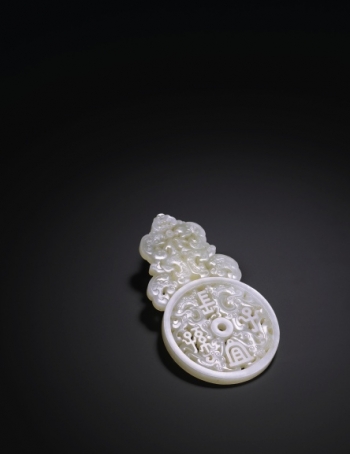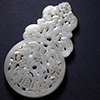Catalogue Note
For millennia, jade was largely an elite art for the aristocracy as it was a laboriously demanding and a time consuming art involving many labor-intensive steps. Historically, it has traditionally been regarded as a prestigious raw material believed to be capable of revitalizing the living and transpiring immorality for the dead. The dictum "By gold and jade put in the nine orifices of a body, the dead could reach immortality", frequently found in many historical records of the third and fourth centuries, coupled with the sheer amounts of jade artifacts found in archaeological burials testify to the material's importance. In retrospect, the Ming dynasty lasted for 276 years before being overthrown by the Manchu. The subsequent Qing dynasty witnessed an adoption of a policy of assimilation of Han traditions, which expands to the realms of its artistic productions and traditions, particularly in the field of jade art.
In retrospect, the Qianlong emperor (1736-1795) achieved various technological advances and innovations in jade craftsmanship.
The Imperial Academy spent fifteen years to compile the largest encyclopedia in the world at the time, entitled Siku quanshu (The Complete Books of the Four Sources), which encompassed a historical record of the significance of an extensive range of an 3457 subjects in a total of 79,070 chapters. The Qianlong emperor's active involvement can be seen through his commentaries on the work, which total more than 130,000 words. Furthermore, the Emperor's connoisseurship and passion for the art of jade is expressed in his 40,000 poems, 800 of which focused solely on the beauty of jade alone. Moreover, the emperor's understanding in the difficulty of quarrying jade is reflected in his commissioning of a jade piece depicting two Muslims moving a stone. The emperor had also composed ten poems describing the quarrying of Hetian jade during 1761 to 1793.
In essence, patronage under the Qing court and the expansion of the Imperial workshop were great contributors to the flourishing of the art of jade. The prevailing taste at the time often predicated upon synthesizing new techniques with classical forms, many of these works are practical while decorative with multiple functions. These elements have the combined effect of pushing the boundaries of jade art beyond the routinized craft skills. By extension, the present lot of a Changyi Zisun jade plaque epitomizes an imitation of these classical forms, as the bi-disc with auspicious phrases intended to induce good fortune appeared during the Eastern Han Dynasty, shown by a jade plaque decorated with raised circular bosses surmounted by the phrase Yi shou in between a pair of confronting archaistic dragons (Fig.1). Other examples have been excavated, such as another jade-bi worked with the three characters Yizisun (luck for offsprings) flanked by a pair of upward facing dragons and surmounted by a bird, all of which rendered in openwork and dated to the Han Dynasty (Fig.2 & 3). The techniques employed such as openwork and the design of a jade plaque portrays an artisan's technical skills. Another piece attributed to the Han Dynasty, the stone mottled with russet inclusions and decorated with a bi-disc adorned with raised bosses beneath a pair of dragons framing the characters Zhangle (Eternal happiness) (Fig.4). These aforementioned examples are essentially prototypes on which the design of the present lot is based upon.
Another closely related example of almost identical size measuring 13.7cm in length, currently residing in the Asian Art Museum of San Francisco feature a piece of pale greenish nephrite worked with the four vertically centered characters Changyi zisun (eternal luck for offspring) with two characters on the upper portion and two within the disc. (Fig.5) Similar to the present lot, the bi disc is surmounted by two confronting dragons with twisted bodies and intertwined tails forming the letter C while a smaller dragonet leans on the back of each larger dragon's neck. Within the disc appear two phoenixes with three small dragonets in close proximity, one on its head, one in its beak, and one in its claws, illustrated in Later Chinese Jades, Ming dynasty to early twentieth Century, Asian art museum, pl.203, p.196. Moreover, according to James C.S. Lin in The Collection of Qing Dynasty Jades in the Fitzwilliam Museum, similar jade plaques were made in the Imperial Palace Workshop until after the fifteenth year of Qianlong's reign in 1750. Likewise, the craftsmen would enumerate their creations on the side of the outer edge according to the characters in Qian zi wen (The Thousand Characters Essay). Compare with a similar jade plaque from the Collection of L. de Luca, sold at Sotheby's Hong Kong, 8 April 2011, lot 2805. See also another Changyi zisun plaque of similar form and dated to the same reign, sold at Christie's New York, 16 September 2010, lot 1094.
In retrospect, the Qianlong emperor (1736-1795) achieved various technological advances and innovations in jade craftsmanship.
The Imperial Academy spent fifteen years to compile the largest encyclopedia in the world at the time, entitled Siku quanshu (The Complete Books of the Four Sources), which encompassed a historical record of the significance of an extensive range of an 3457 subjects in a total of 79,070 chapters. The Qianlong emperor's active involvement can be seen through his commentaries on the work, which total more than 130,000 words. Furthermore, the Emperor's connoisseurship and passion for the art of jade is expressed in his 40,000 poems, 800 of which focused solely on the beauty of jade alone. Moreover, the emperor's understanding in the difficulty of quarrying jade is reflected in his commissioning of a jade piece depicting two Muslims moving a stone. The emperor had also composed ten poems describing the quarrying of Hetian jade during 1761 to 1793.
In essence, patronage under the Qing court and the expansion of the Imperial workshop were great contributors to the flourishing of the art of jade. The prevailing taste at the time often predicated upon synthesizing new techniques with classical forms, many of these works are practical while decorative with multiple functions. These elements have the combined effect of pushing the boundaries of jade art beyond the routinized craft skills. By extension, the present lot of a Changyi Zisun jade plaque epitomizes an imitation of these classical forms, as the bi-disc with auspicious phrases intended to induce good fortune appeared during the Eastern Han Dynasty, shown by a jade plaque decorated with raised circular bosses surmounted by the phrase Yi shou in between a pair of confronting archaistic dragons (Fig.1). Other examples have been excavated, such as another jade-bi worked with the three characters Yizisun (luck for offsprings) flanked by a pair of upward facing dragons and surmounted by a bird, all of which rendered in openwork and dated to the Han Dynasty (Fig.2 & 3). The techniques employed such as openwork and the design of a jade plaque portrays an artisan's technical skills. Another piece attributed to the Han Dynasty, the stone mottled with russet inclusions and decorated with a bi-disc adorned with raised bosses beneath a pair of dragons framing the characters Zhangle (Eternal happiness) (Fig.4). These aforementioned examples are essentially prototypes on which the design of the present lot is based upon.
Another closely related example of almost identical size measuring 13.7cm in length, currently residing in the Asian Art Museum of San Francisco feature a piece of pale greenish nephrite worked with the four vertically centered characters Changyi zisun (eternal luck for offspring) with two characters on the upper portion and two within the disc. (Fig.5) Similar to the present lot, the bi disc is surmounted by two confronting dragons with twisted bodies and intertwined tails forming the letter C while a smaller dragonet leans on the back of each larger dragon's neck. Within the disc appear two phoenixes with three small dragonets in close proximity, one on its head, one in its beak, and one in its claws, illustrated in Later Chinese Jades, Ming dynasty to early twentieth Century, Asian art museum, pl.203, p.196. Moreover, according to James C.S. Lin in The Collection of Qing Dynasty Jades in the Fitzwilliam Museum, similar jade plaques were made in the Imperial Palace Workshop until after the fifteenth year of Qianlong's reign in 1750. Likewise, the craftsmen would enumerate their creations on the side of the outer edge according to the characters in Qian zi wen (The Thousand Characters Essay). Compare with a similar jade plaque from the Collection of L. de Luca, sold at Sotheby's Hong Kong, 8 April 2011, lot 2805. See also another Changyi zisun plaque of similar form and dated to the same reign, sold at Christie's New York, 16 September 2010, lot 1094.


